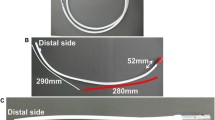Abstract
We hypothesized that the externalizing direction of the driveline (the driveline angle) at the percutaneous exit site would influence the occurrence of driveline infection after left ventricular assist device implantation. From August 2013 to May 2017, 71 patients were implanted with a HeartMate II device in our center. The driveline angle was measured on anteroposterior radiography just after implantation. Risk factors for driveline infection were analyzed by uni- and multivariate analyses. Driveline infection developed in 10 (14%) patients during follow-up. Overall actual freedoms from driveline infection at 6, 12, and 24 months were 96%, 88%, and 86%, respectively. Overall number of driveline infection events per patient-year was 0.16. Receiver operating characteristic analysis determined the cut-off point of the driveline angle as 41°. The 6-, 12-, and 24-month actuarial freedoms from driveline infection in those with driveline angle more than 42° (84%, 74%, and 74%, respectively) were significantly lower than in those with driveline angle less than 41° (97%, 94%, and 90%, respectively; p < 0.02). The numbers of driveline infection events per patient-year were 0.16 in patients with driveline angle more than 42°, and 0.04 in patients with driveline angle less than 41°. Multivariate analysis demonstrated that driveline angle more than 42° was an independent risk factor for driveline infection (hazard ratio 4.71). Driveline angle more than 42° is an independent risk factor for driveline infection in patients with HeartMate II. Externalization of the driveline toward the horizontal direction is important to prevent driveline infection with HeartMate II.



Similar content being viewed by others
References
Fujita T, et al. Right heart failure and benefits of adjuvant tricuspid valve repair in patients undergoing left ventricular assist device implantation. Eur J Cardiothorac Surg. 2014;46(5):802–7.
Matsumoto Y, et al., 889 days of support on hydrodynamic bearing rotation mode of the DuraHeart for bridge-to-heart transplantation. J Artif Organs. 2017;20:270–273
Hata H, et al. Pathological analysis of the aortic valve after long-term left ventricular assist device support. Eur J Cardiothorac Surg. 2014;46(2):193–7.
Cagliostro B, et al. Continuous-flow left ventricular assist devices and usefulness of a standardized strategy to reduce drive-line infections. J Heart Lung Transpl. 2016;35(1):108–14.
Schaffer JM, et al. Infectious complications after pulsatile-flow and continuous-flow left ventricular assist device implantation. J Heart Lung Transpl. 2011;30(2):164–74.
Dean D, et al. Reduction in driveline infection rates: Results from the HeartMate II Multicenter Driveline Silicone Skin Interface (SSI) Registry. J Heart Lung Transpl. 2015;34(6):781–9.
Imamura T, et al. Correlation between driveline features and driveline infection in left ventricular assist device selection. J Artif Organs. 2017;20(1):34–41.
Matsumoto Y, et al. Comparison of hemodynamic performance and clinical results with EVAHEART versus HeartMate II. ASAIO J. 2017;63(5):562–7.
Goldstein DJ, et al. Continuous-flow devices and percutaneous site infections: clinical outcomes. J Heart Lung Transpl. 2012;31(11):1151–7.
Choi L, et al. Development of an infection-resistant LVAD driveline: a novel approach to the prevention of device-related infections. J Heart Lung Transpl. 1999;18(11):1103–10.
Interagency Registry for Mechanically Assisted Circulatory Support, National Heart Lung and Blood Institute. Adverse event definitions. Contract Award HHSN268201100025C. http://www.uab.edu/medicine/intermacs/manual-of-operations/manual-of-operations-dropdown3/appendix-a-adverse-event-definitions. Accessed 12 Dec 2013.
McMurray JJ, et al. ESC guidelines for the diagnosis and treatment of acute and chronic heart failure 2012: the task force for the diagnosis and treatment of acute and chronic heart failure 2012 of the European Society of Cardiology. Developed in collaboration with the Heart Failure Association (HFA) of the ESC. Eur Heart J. 2012;33(14):1787–847.
Yancy CW, et al. 2013 ACCF/AHA guideline for the management of heart failure: executive summary. J Am Coll Cardiol. 2013;62(16):1495–539.
Hieda M, et al. Importance of early appropriate intervention including antibiotics and wound care for device-related infection in patients with left ventricular assist device. Transpl Proc. 2014;46(3):907–10.
Acknowledgements
The authors would like to thank Yuzo Takahashi, Hideki Yotsuida, Hiroshi Nishioka, Megumi Komiyama, Maiko Hattori, Yuto Kimura, Mao Nakahashi, Takaaki Nagai, Ayaka Arizono, Tomoko Tokunaga, Toshikazu Arai, Eri Miyoshi, Ai Nagayo, Nobuaki Konishi, Yumiko Hori, and Takako Nakaya for their roles in providing patient care. We thank Kelly Zammit, BVSc, from Edanz Group (http://www.edanzediting.com/ac), for editing a draft of this manuscript.
Funding
None declared.
Author information
Authors and Affiliations
Corresponding author
Ethics declarations
Conflict of interest
Authors declare that they have no conflict of interest.
Rights and permissions
About this article
Cite this article
Matsumoto, Y., Fukushima, S., Shimahara, Y. et al. Driveline angle is crucial for preventing driveline infection in patients with HeartMate II device. J Artif Organs 22, 37–43 (2019). https://doi.org/10.1007/s10047-018-1074-x
Received:
Accepted:
Published:
Issue Date:
DOI: https://doi.org/10.1007/s10047-018-1074-x




